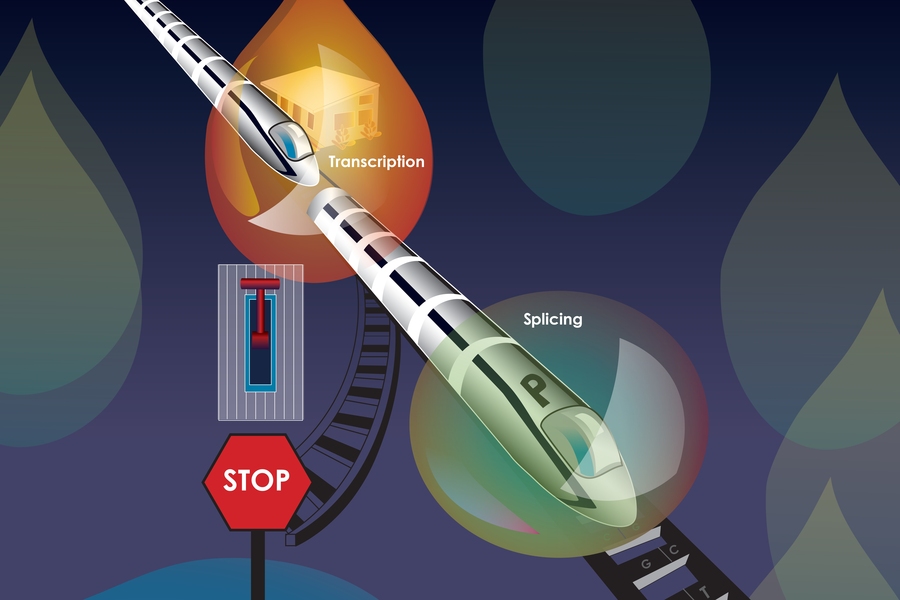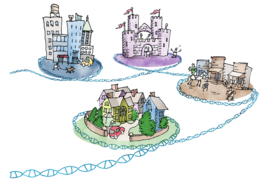Cells often create compartments to control important biological functions. The nucleus is a prime example; surrounded by a membrane, it houses the genome. Yet cells also harbor enclosures that are not membrane-bound and more transient, like oil droplets in water. Over the past two years, these droplets (called “condensates”) have become increasingly recognized as major players in controlling genes. Now, a team led by Whitehead Institute scientists helps expand this emerging picture with the discovery that condensates play a role in splicing, an essential activity that ensures the genetic code is prepared to be translated into protein. The researchers also reveal how a critical piece of cellular machinery moves between different condensates. The team’s findings appear in the Aug. 7 online issue of Nature.
“Condensates represent a real paradigm shift in the way molecular biologists think about gene control,” says senior author Richard Young, a member of the Whitehead Institute and professor of biology at MIT. “Now, we’ve added a critical new layer to this thinking that enhances our understanding of splicing as well as the major transcriptional apparatus RNA polymerase II.”
Young’s lab has been at the forefront of studying how and when condensates form as well as their functions in gene regulation. In the current study, Young and his colleagues, including first authors Eric Guo and John Manteiga, focused their efforts on a key transition that happens when genes undergo transcription — an early step in gene activation whereby an RNA copy is created from the genes’ DNA template. First, all of the molecular machinery needed to make RNA, including a large protein complex known as RNA polymerase II, assembles at a given gene. Then, specific chemical modifications to RNA polymerase II allow it to begin transcribing DNA into RNA. This shift from so-called transcription initiation to active transcription also involves another important molecular transition: As RNA molecules begin to grow, the splicing apparatus must also move in and carry out its job.
“We wanted to step back and ask, ‘Do condensates play an important role in this switch, and if so, what mechanism might be responsible?’” explains Young.
For roughly three decades, it has been recognized that the factors required for splicing are stored in compartments called speckles. Yet whether these speckles play an active role in splicing, or are simply storage vessels, has remained unclear.
Using confocal microscopy, the Whitehead team discovered condensates filled with components of the splicing machinery in the vicinity of highly active genes. Notably, these structures exhibited similar liquid-like characteristics to those condensates described in prior studies from Young’s lab that are involved in transcription initiation.
“These findings signaled to us that there are two types of condensates at work here: one involved in transcription initiation and the other in splicing and transcriptional elongation,” said Manteiga, a graduate student in Young’s lab.
With two different condensates at play, the researchers wondered: How does the critical transcriptional machinery, specifically RNA polymerase II, move from one condensate to the other?
Guo, Manteiga, and their colleagues found that chemical modification, specifically the addition of phosphate groups, serves as a kind of molecular switch that alters the protein complex’s affinity for a particular condensate. With fewer phosphate groups, it associates with the condensates for transcription initiation; when more phosphates are added, it enters the splicing condensates. Such phosphorylation occurs on one end of the protein complex, which contains a specialized region known as the C-terminal domain (CTD). Importantly, the CTD lacks a specific three-dimensional structure, and previous work has shown that such intrinsically disordered regions can influence how and when certain proteins are incorporated into condensates.
“It is well-documented that phosphorylation acts as a signal to help regulate the activity of RNA polymerase II,” says Guo, a postdoc in Young’s lab. “Now, we’ve shown that it also acts as a switch to alter the protein’s preference for different condensates.”
In light of their discoveries, the researchers propose a new view of splicing compartments, where speckles serve primarily as warehouses, storing the thousands of molecules required to support the splicing apparatus when they are not needed. But when splicing is active, the phosphorylated CTD of RNA Pol II serves as an attractant, drawing the necessary splicing materials toward the gene where they are needed and into the splicing condensate.
According to Young, this new outlook on gene control has emerged in part through a multidisciplinary approach, bringing together perspectives from biology and physics to learn how properties of matter predict some of the molecular behaviors he and his team have observed experimentally. “Working at the interface of these two fields is incredibly exciting,” says Young. “It is giving us a whole new way of looking at the world of regulatory biology.”
Support for this work was provided by the U.S. National Institutes of Health, National Science Foundation, Cancer Research Institute, Damon Runyon Cancer Research Foundation, Hope Funds for Cancer Research, Swedish Research Council, and German Research Foundation DFG.








